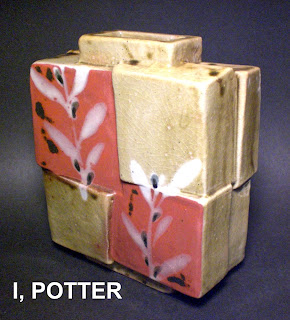My first encounter with the work of
Kimura Ichiro was back in the very early 1980's, I had acquired a group of
exhibition catalogues from a book dealer and among them was one on Kimura from
1976. There was quite the array of pieces from thrown to the molded henko pots
and each had a distinctly folk art look of Mashiko-yaki. On our first trip to
Japan in 1990 and subsequent ones we were able to see a large number of his
pots especially in Mashiko, where his work was displayed in a number of
galleries. What became immediately apparent was that while Hamada Shoji was a
product of a variety of his experiences and travels, it is safe to say, Kimura
Ichiro was a product of Mashiko and the community and lifestyle that Hamada and
other Mashiko potters had crafted out of a long standing craft tradition.
Kimura Ichiro (1915-1978) studied with Hamada Shoji prior to WW II and after
his apprenticeship set up his studio and kiln in Mashiko and fired his first
kiln load of pots in1947. Like fellow Hamada students Shimaoka Tatsuzo and Murata
Gen, Kimua Ichiro has gone on to be a major fixture of Mashiko pottery and was
part of a major exhibit of Mashiko potters in the late 90's. His son, Kimura
Mitsuru, continues in his father's footsteps.
Illustrated is a form that
appears creatively composed of stacked blocks around a central core; this
signature vase by Kimura Ichiro changes with each angle and perspective it is
viewed. Having a touch of M.C. Escher in its design, this clearly is one of his
best and most well known forms along with his more traditional Hamada Shoji
style molded bottle and his quirky "football" style henko. The pot is
covered in a yellow ash glaze with red high-lighted quadrants with white and
copper accented sprigs of floral decoration on both front and back. This vase
is a rather purposeful and resolute piece that has volumes to say about
Mashiko-yaki and Japanese pottery of the post-war period; function, design and presence.

No comments:
Post a Comment